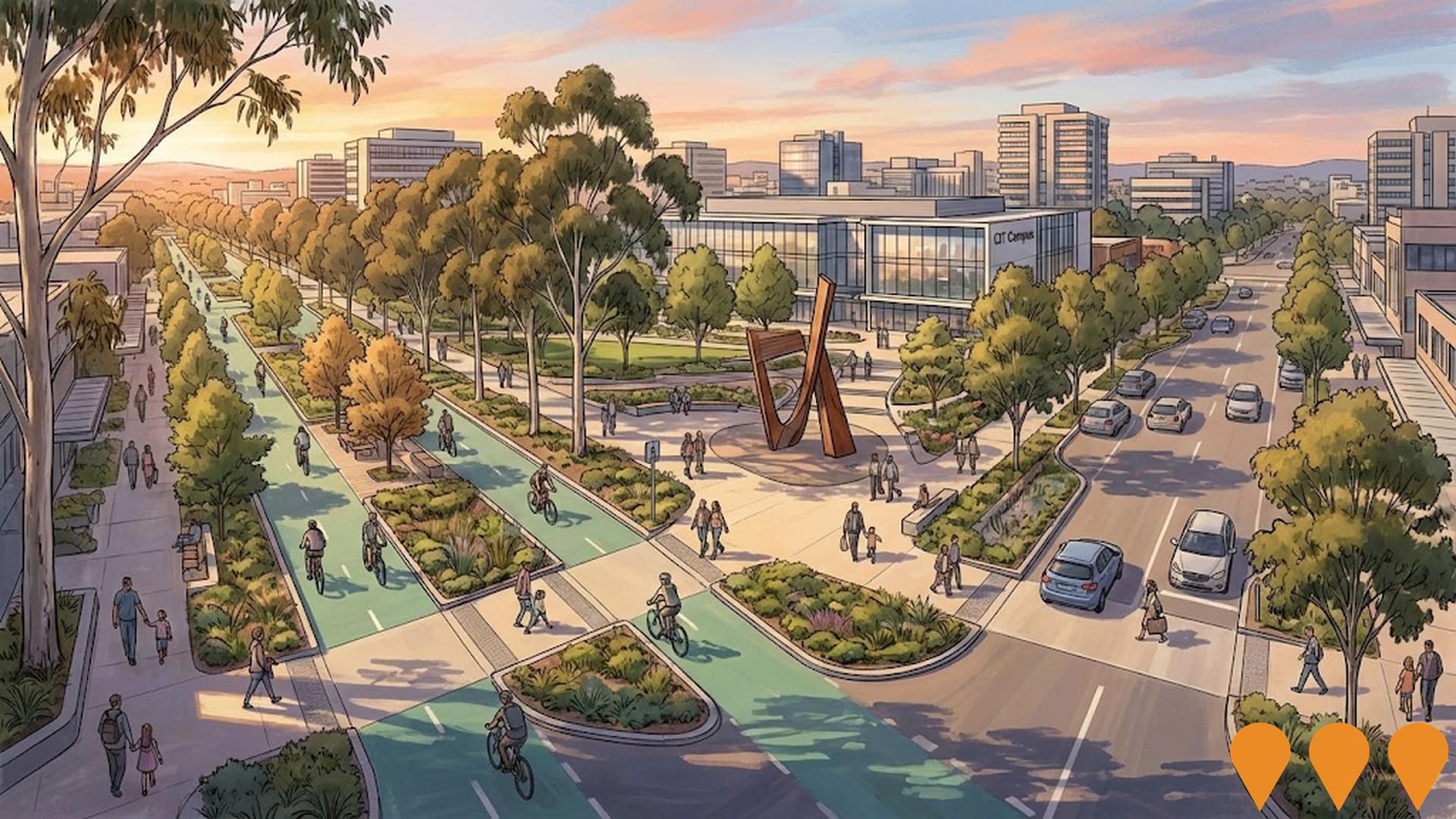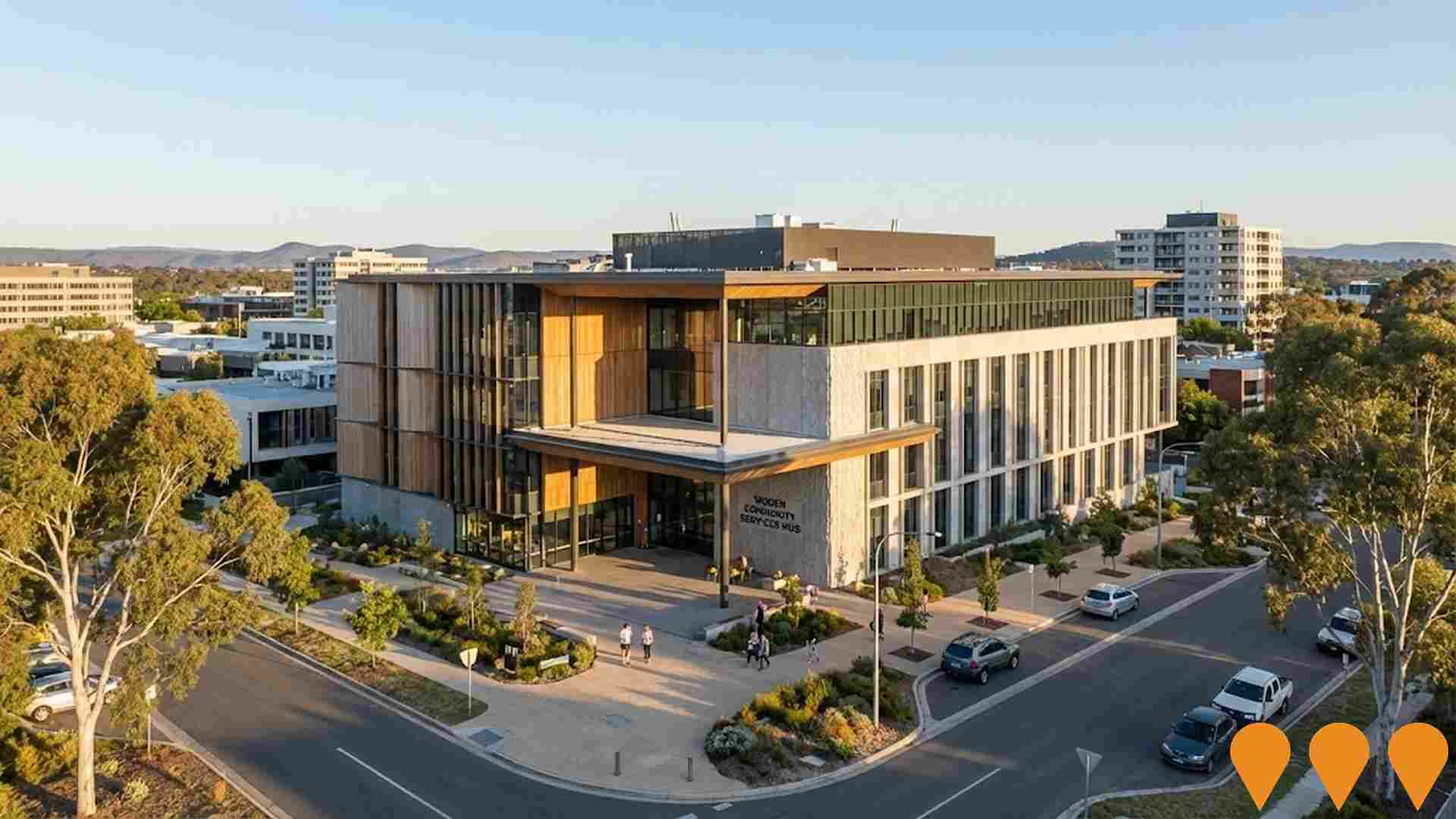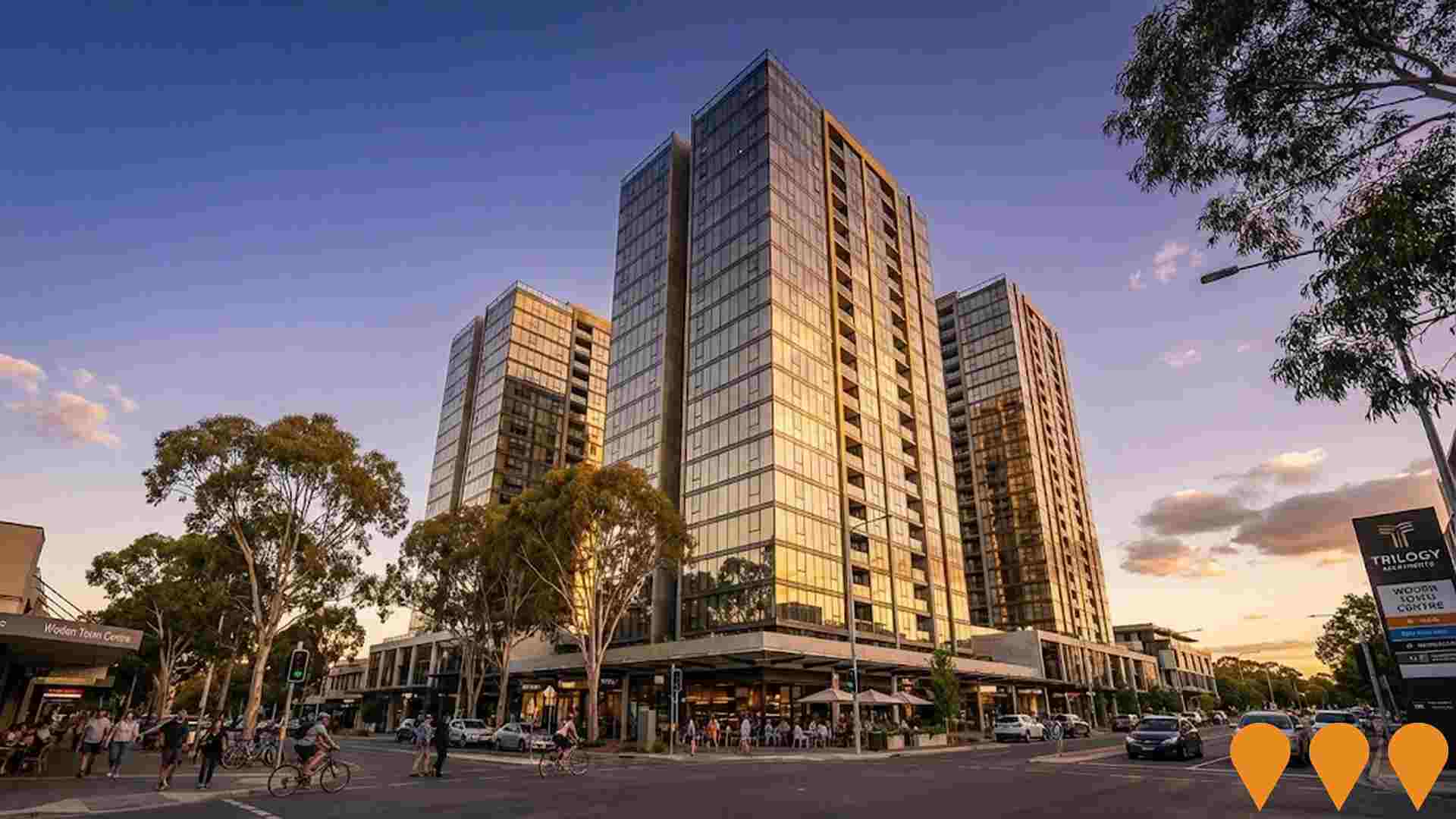Chart Color Schemes
est. as @ -- *
ABS ERP | -- people | --
2021 Census | -- people
Sales Activity
Curious about local property values? Filter the chart to assess the volume and appreciation (including resales) trends and regional comparisons, or scroll to the map below view this information at an individual property level.
Find a Recent Sale
Sales Detail
Population
An assessment of population growth drivers in Hughes reveals an overall ranking slightly below national averages considering recent, and medium term trends
Hughes' population, as per AreaSearch's analysis, is approximately 3,163 as of August 2025. This figure represents a decrease of 47 individuals since the 2021 Census, which reported a population of 3,210 people. The change is inferred from the estimated resident population of 3,150 in June 2024 and an additional 16 validated new addresses since the Census date. This results in a population density ratio of 1,767 persons per square kilometer, which exceeds the average across national locations assessed by AreaSearch. Overseas migration primarily drove population growth in the area during recent periods.
AreaSearch adopts ABS/Geoscience Australia projections for each SA2 area, released in 2024 with a base year of 2022. For areas not covered and years post-2032, age group growth rates from the ACT Government's SA2 area projections, also based on 2022, are used. Future population trends indicate an overall decline by 242 persons by 2041 according to these projections. However, specific age cohorts are expected to grow, notably the 65-74 age group projected to increase by 10 people.
Frequently Asked Questions - Population
Development
AreaSearch assessment of residential development drivers sees a low level of activity in Hughes, placing the area among the bottom 25% of areas assessed nationally
Hughes has recorded approximately six residential properties granted approval per year. Over the past five financial years, from FY-21 to FY-25, 34 homes were approved, with one more approved so far in FY-26. The population decline in recent years has resulted in an adequate housing supply relative to demand, creating a balanced market with good buyer choice.
New properties are constructed at an average value of $381,000. This financial year, there have been $176,000 in commercial approvals, indicating a predominantly residential focus. Compared to the Australian Capital Territory, Hughes records significantly lower building activity, 87.0% below the regional average per person. This limited new supply generally supports stronger demand and values for established properties. Nationally, this is also below average, reflecting the area's maturity and possible planning constraints.
New development consists of 67.0% detached houses and 33.0% townhouses or apartments, offering a range of medium-density options across various price brackets. Hughes indicates a mature market with around 423 people per approval. With population projections showing stability or decline, housing demand pressures are expected to reduce, benefiting potential buyers.
Frequently Asked Questions - Development
Infrastructure
Hughes has strong levels of nearby infrastructure activity, ranking in the top 30% nationally
AreaSearch has identified three projects that may impact the area's performance due to changes in local infrastructure. These key projects are Trilogy Apartments, Federal Golf Club Retirement Village, Woden Experiment Stage 2 - Public Realm & Active Travel Upgrades, and Woden Bus Depot and Transport Interchange. The following list details those considered most relevant.
Professional plan users can use the search below to filter and access additional projects.
INFRASTRUCTURE SEARCH
 Denotes AI-based impression for illustrative purposes only, not to be taken as definitive under any circumstances. Please follow links and conduct other investigations from the project's source for actual imagery. Developers and project owners wishing us to use original imagery please Contact Us and we will do so.
Denotes AI-based impression for illustrative purposes only, not to be taken as definitive under any circumstances. Please follow links and conduct other investigations from the project's source for actual imagery. Developers and project owners wishing us to use original imagery please Contact Us and we will do so.
Frequently Asked Questions - Infrastructure
Canberra Hospital Master Plan
Long-term transformation of Canberra Hospital campus (2021-2041). The new Critical Services Building (Building 5) opened in 2023. Multiple stages are now in construction or detailed planning, including SPIRE Stage 1 (new emergency, surgical and intensive care facilities) and ongoing campus renewal works to deliver modern clinical facilities.

Woden Town Square Precinct Redevelopment
A major mixed-use urban renewal precinct featuring a new public town square, residential apartments, commercial office space, retail, and community facilities as the centrepiece of Woden's revitalisation.

Canberra Hospital Critical Services Building (SPIRE Centre)
Australia's first fully-electric hospital building, the Canberra Hospital Critical Services Building (also known as SPIRE Centre), is an eight-storey, 45,000 square metre facility. It includes a new Emergency Department with 128 treatment spaces, a 48-bed Intensive Care Unit with two outdoor terraces, 22 operating theatres, 148 inpatient beds, cardiac catheter laboratories, and enhanced radiology and pathology services. The largest healthcare infrastructure project in ACT history, it was built by Multiplex with a 5 Star Green Star design rating, featuring innovative sustainability measures. Completed and opened August 2024.

Woden Experiment Stage 2 - Public Realm & Active Travel Upgrades
Major public realm upgrades including new cycling paths, widened footpaths, tree planting, public art and improved connectivity around the new CIT Campus and town centre.

Woden Community Services Hub
A new four-storey facility in Woden Town Centre that will centralise community and government services under one roof, bringing together services currently operating from multiple buildings in the region. It will include child and family services, other community services, meeting rooms, a multi-purpose hall, and workshop spaces to provide efficient support to residents.

Woden Bus Depot and Transport Interchange
The Woden Bus Depot is completed and operational as Australia's largest electric bus depot, capable of housing and charging up to 100 electric buses with modern maintenance facilities. The Woden Transport Interchange is under construction and will be light rail enabled, featuring improved passenger facilities including wide footpaths, enhanced lighting, shelters, bike storage, toilets, and landscaping for better safety and connectivity.

Trilogy Apartments
Three-tower residential development featuring contemporary design and integrated retail spaces. Contributing to Woden town centre revitalization.

Federal Golf Club Retirement Village
A proposed Over 55s retirement village of up to 125 dwellings, including 77 single-storey homes and 48 apartments in six three-storey buildings. The project is a partnership between the Federal Golf Club and developer Mbark. The development has faced some community opposition and legal challenges. Redevelopment of Federal Golf Club into a $100M retirement village with 125 independent living units.

Employment
AreaSearch assessment positions Hughes ahead of most Australian regions for employment performance
Hughes has an educated workforce with significant representation in essential services sectors. Its unemployment rate was 2.5% as of June 2025, which is lower than the Australian Capital Territory's (ACT) rate of 3.4%.
The area experienced employment growth of 1.4% over the past year. As of June 2025, 1,624 residents were employed with an unemployment rate of 0.9% below ACT's rate. Workforce participation in Hughes was 61.4%, compared to ACT's 69.6%. Key industries for employment among residents are public administration & safety, health care & social assistance, and professional & technical services.
Notably, health care & social assistance is strongly specialized with an employment share of 1.3 times the regional level. Conversely, construction is under-represented at 4.2% compared to ACT's 6.8%. Employment opportunities locally may be limited as indicated by Census data. Between June 2024 and June 2025, employment levels increased by 1.4%, labour force grew by 1.6%, causing the unemployment rate to rise by 0.3 percentage points. In comparison, ACT recorded employment growth of 1.9% with a decrease in unemployment of 0.3 percentage points. Future employment demand within Hughes can be inferred from Jobs and Skills Australia's national employment forecasts issued in May 2025. These projections suggest national employment will expand by 6.6% over five years and 13.7% over ten years, with varying growth rates across industry sectors. Applying these projections to Hughes' employment mix indicates potential local growth of approximately 6.8% over five years and 13.9% over ten years.
Frequently Asked Questions - Employment
Income
The economic profile demonstrates exceptional strength, placing the area among the top 10% nationally based on comprehensive AreaSearch income analysis
AreaSearch's latest postcode level ATO data for financial year 2022 shows Hughes's median income among taxpayers is $74,575 and the average is $103,767. Nationally, this places Hughes in the top percentile. The Australian Capital Territory has a median of $68,678 and an average of $83,634. By September 2025, estimates suggest the median income will be approximately $84,717 and the average will be around $117,879, based on Wage Price Index growth of 13.6% since financial year 2022. According to the 2021 Census, incomes in Hughes rank highly nationally, between the 95th and 95th percentiles for household, family, and personal incomes. Income analysis reveals that 35.5% of locals (1,122 people) fall into the $4000+ category, differing from regional levels where the $1,500 - 2,999 category predominates at 34.3%. A substantial proportion of high earners (48.2% above $3,000/week) indicates strong economic capacity in the area. After housing costs, residents retain 88.1% of their income, reflecting strong purchasing power and the area's SEIFA income ranking places it in the 9th decile.
Frequently Asked Questions - Income
Housing
Hughes is characterized by a predominantly suburban housing profile, with above-average rates of outright home ownership
Hughes' dwelling structure, as per the latest Census, consisted of 73.6% houses and 26.4% other dwellings (semi-detached, apartments, 'other' dwellings). This compares to Australian Capital Territory's 58.4% houses and 41.7% other dwellings. Home ownership in Hughes stood at 37.7%, with mortgaged dwellings at 37.8% and rented ones at 24.5%. The median monthly mortgage repayment was $2,700, higher than the Australian Capital Territory average of $2,167. Median weekly rent in Hughes was $400, compared to Australian Capital Territory's $440. Nationally, Hughes' mortgage repayments exceeded the Australian average of $1,863, while rents were higher than the national figure of $375.
Frequently Asked Questions - Housing
Household Composition
Hughes has a typical household mix, with a higher-than-average median household size
Family households account for 72.1% of all households, including 36.7% couples with children, 24.8% couples without children, and 9.0% single parent families. Non-family households constitute the remaining 27.9%, with lone person households at 25.6% and group households comprising 2.8%. The median household size is 2.6 people, larger than the Australian Capital Territory average of 2.4.
Frequently Asked Questions - Households
Local Schools & Education
Hughes demonstrates exceptional educational outcomes, ranking among the top 5% of areas nationally based on AreaSearch's comprehensive analysis of qualification and performance metrics
Hughes has a notably high educational attainment among residents aged 15 and above, with 58.7% holding university qualifications compared to the national average of 30.4% and the SA4 region's 46.8%. Bachelor degrees are most common at 31.2%, followed by postgraduate qualifications (20.8%) and graduate diplomas (6.7%). Vocational pathways account for 16.9%, with advanced diplomas at 8.4% and certificates at 8.5%. Educational participation is high, with 30.9% of residents currently enrolled in formal education.
This includes 10.1% in primary, 9.0% in secondary, and 6.1% in tertiary education. Hughes Primary School serves the local area with an enrollment of 433 students. The school's Index of Community Socio-Educational Advantage (ICSEA) is 1151, indicating high advantage compared to national averages. There is one primary school in Hughes, with secondary options available nearby. The school places per 100 residents are lower than the regional average at 13.7 versus 18.4.
Frequently Asked Questions - Education
Schools Detail
Nearby Services & Amenities
Transport
Transport servicing is moderate compared to other areas nationally based on assessment of service frequency, route connectivity and accessibility
Hughes has nine active public transport stops operating within its boundaries. These stops are served by a mix of buses along two different routes. Together, these routes facilitate 341 weekly passenger trips.
Residents have good accessibility to transport, with an average distance of 268 meters to the nearest stop. The service frequency is 48 trips per day across all routes, translating to approximately 37 weekly trips per individual stop.
Frequently Asked Questions - Transport
Transport Stops Detail
Health
Health performance in Hughes is lower than average with common health conditions somewhat prevalent across both younger and older age cohorts
Hughes faces significant health challenges, with common health conditions prevalent across both younger and older age cohorts. The rate of private health cover is exceptionally high at approximately 73% of the total population (2,296 people), compared to 68.1% across Australian Capital Territory. Nationally, this figure stands at 55.3%.
The most common medical conditions are arthritis and asthma, impacting 8.9 and 8.0% of residents respectively. Meanwhile, 67.3% of residents declared themselves completely clear of medical ailments, compared to 70.1% across Australian Capital Territory. The area has 19.4% of residents aged 65 and over (614 people), which is higher than the 18.3% in Australian Capital Territory. Health outcomes among seniors present some challenges, broadly in line with the general population's health profile.
Frequently Asked Questions - Health
Cultural Diversity
Hughes was found to be more culturally diverse than the vast majority of local markets in Australia, upon assessment of a range of language and cultural background related metrics
Hughes had a higher cultural diversity compared to most local markets, with 26.4% of its population born overseas and 16.4% speaking a language other than English at home. Christianity was the predominant religion in Hughes, accounting for 43.6% of the population. Judaism showed an overrepresentation in Hughes, comprising 0.5% compared to the Australian Capital Territory's 0.3%.
The top three ancestry groups were Australian (25.5%), English (25.1%), and Irish (10.7%). Notable divergences included Welsh at 1.3%, Hungarian at 0.5%, and Polish at 1.0%, all higher than their respective regional percentages of 0.6%, 0.3%, and 0.8%.
Frequently Asked Questions - Diversity
Age
Hughes hosts an older demographic, ranking in the top quartile nationwide
Hughes has a median age of 42, which is higher than the Australian Capital Territory figure of 35 and significantly higher than Australia's median age of 38. Compared to the Australian Capital Territory average, Hughes has an over-representation of the 85+ cohort (4.8% locally), while the 25-34 year-olds are under-represented (9.5%). Between 2021 and the present, the population aged 15-24 increased from 11.0% to 13.8%, and the 35-44 cohort grew from 13.0% to 14.6%. Conversely, the 85+ cohort declined from 6.5% to 4.8%, and the 55-64 group decreased from 12.0% to 10.9%. By 2041, demographic modeling suggests Hughes's age profile will evolve significantly. The 85+ age cohort is projected to expand by 7 people (5%), from 150 to 158. Notably, the combined 65+ age groups are expected to account for 100% of total population growth, reflecting the area's aging demographic profile. Meanwhile, the 0-4 and 75-84 cohorts are expected to experience population declines.


